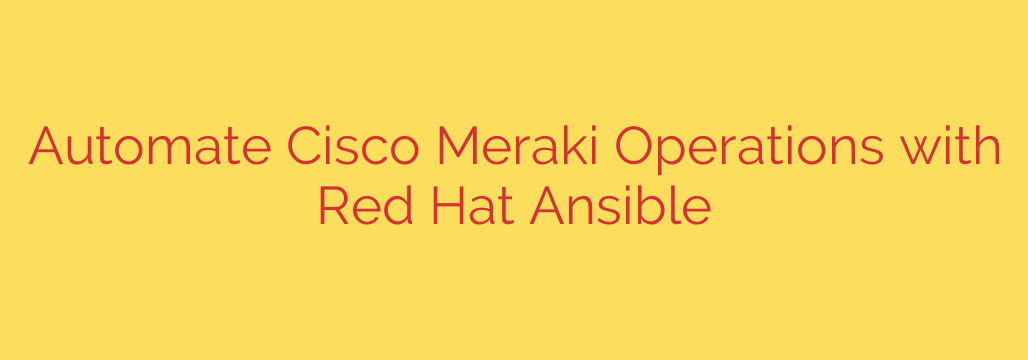
Managing modern network infrastructure, especially across multiple sites or large deployments, can be a complex and time-consuming task. Manually configuring devices, pushing updates, and ensuring policy compliance consumes valuable IT resources that could be better spent on strategic initiatives. This is where network automation becomes essential.
For organizations leveraging Cisco Meraki devices, which are known for their centralized management and cloud-based platform, the potential for automation is immense. While the Meraki dashboard simplifies many tasks, repetitive operations can still benefit greatly from programmatic control. This is where powerful automation tools come into play.
Red Hat Ansible is a leading automation platform that provides a simple yet powerful way to automate IT workflows, including network device configuration and management. Unlike some automation tools, Ansible is agentless, meaning it doesn’t require software installed on the managed devices, making it ideal for interacting with APIs offered by modern network platforms like Cisco Meraki.
By combining the capabilities of Cisco Meraki’s API with Ansible’s automation engine, network administrators can achieve unprecedented levels of efficiency, consistency, and scalability.
How Ansible Automates Meraki Operations
Ansible interacts with Meraki by utilizing purpose-built modules that translate human-readable tasks into API calls. These modules handle the communication with the Meraki cloud platform, allowing you to manage various aspects of your network programmatically.
Instead of logging into the dashboard and clicking through menus for each task, you write Ansible Playbooks. These are YAML files that define a series of steps (or ‘tasks’) to be executed on your infrastructure. A playbook can describe the desired state of your network configuration, and Ansible will work to achieve that state.
For example, an Ansible playbook can:
- Configure wireless networks: Set up SSIDs, security settings, and access controls across multiple sites simultaneously.
- Manage firewall rules and security policies: Ensure consistent security posture across your entire Meraki network.
- Deploy firmware updates: Schedule and execute updates in a controlled and automated manner.
- Monitor device status and pull data: Gather information about your network inventory, configuration, or performance.
- Onboard new devices: Quickly add and configure new Meraki devices as they come online.
- Enforce configuration compliance: Automatically detect and remediate deviations from your standard configurations.
Key Benefits of Using Ansible with Meraki
Implementing Ansible automation for your Meraki network yields significant advantages:
- Increased Speed and Efficiency: Tasks that might take hours or even days to complete manually can be finished in minutes.
- Reduced Human Error: Automation eliminates the risk of typos and misconfigurations that often occur during manual operations.
- Enhanced Consistency: Ensure configurations are applied uniformly across all devices and sites, improving reliability and security.
- Improved Scalability: Easily manage a growing number of devices and sites without a linear increase in administrative overhead.
- Better Documentation: Playbooks serve as self-documenting infrastructure code, making it easier to understand and audit configurations.
- Faster Troubleshooting: Standardized configurations make it quicker to identify and resolve issues.
- Enable DevOps Practices: Integrate network changes into existing CI/CD pipelines for truly automated deployments.
Getting Started with Meraki Automation using Ansible
To begin automating your Meraki operations with Ansible, you’ll typically need:
- Access to a Cisco Meraki Dashboard.
- An API key generated from your Meraki dashboard (ensure it has appropriate permissions).
- A server or workstation with Ansible installed.
- The relevant Ansible Meraki modules (often included with Ansible or easily installed).
You’ll then write playbooks targeting your Meraki network, defining the desired configuration or action using the Meraki modules.
Transform Your Network Management
Automating Cisco Meraki operations with Red Hat Ansible is a strategic move that can transform how your IT team manages the network. It shifts focus from repetitive, manual tasks to strategic initiatives, enabling your organization to be more agile, secure, and efficient. Explore the possibilities of Meraki automation and unlock the full potential of your network infrastructure.
Source: https://feedpress.me/link/23532/17040008/streamline-operations-with-cisco-meraki-and-red-hat-ansible-automation








